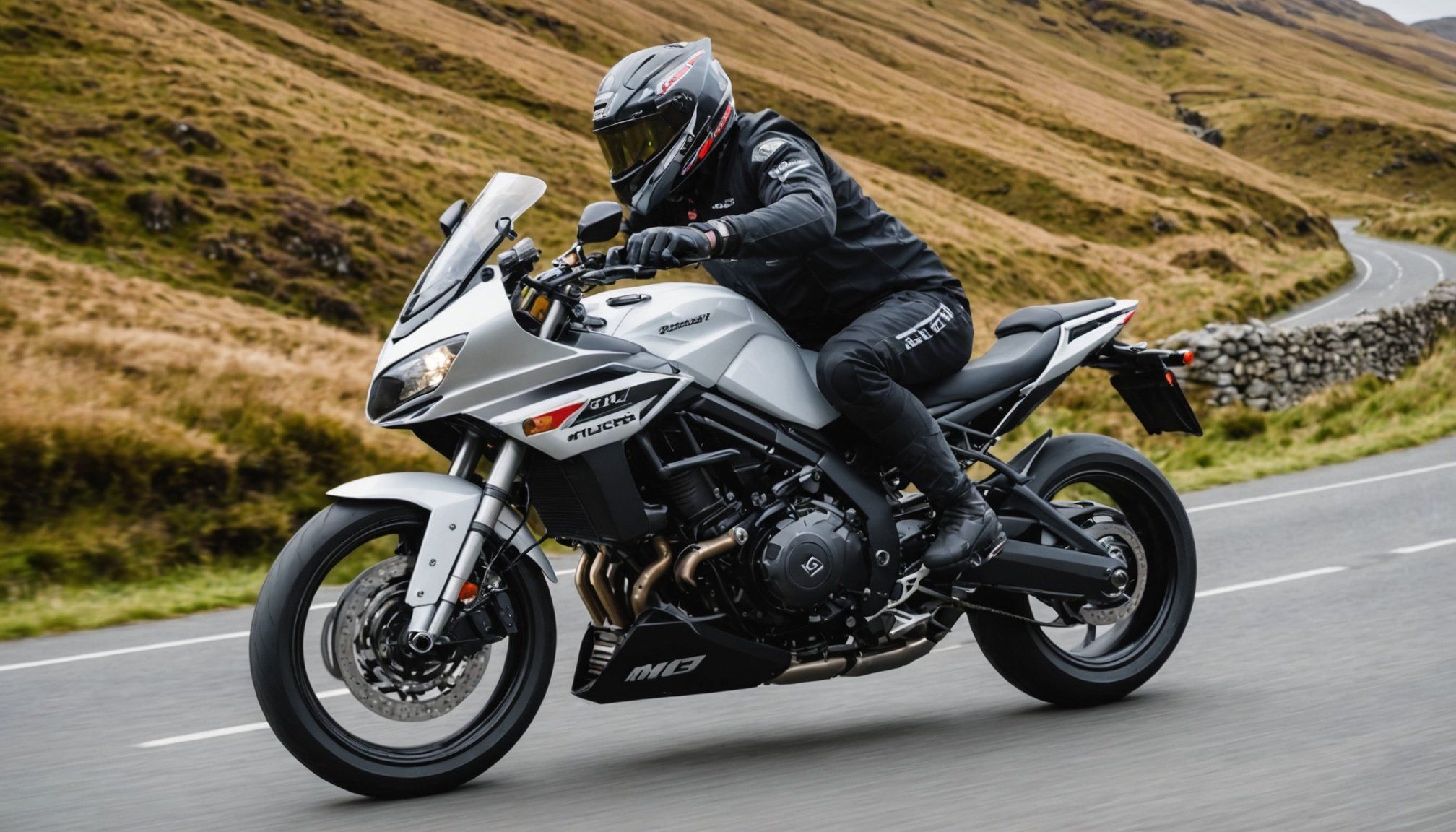Unlocking the Ideal Gear Ratio for Mastering Hills on Your Sport Bike in the Scenic Lake District
Understanding the Importance of Gear Ratios
When it comes to tackling the challenging hills of the Lake District on your sport bike, whether it’s a road bike, mountain bike, or any other type, the gear ratio is crucial for a successful and enjoyable ride. The right gear ratio can make the difference between a grueling climb and a manageable one, allowing you to conserve energy and enjoy the scenic views.
Factors to Consider
Before diving into the specifics of gear ratios, it’s essential to consider several key factors that influence your choice:
This might interest you : Comprehensive handbook for choosing and installing aftermarket frame sliders on uk sport motorcycles
- Terrain: The Lake District is known for its varied terrain, from gentle slopes to steep inclines. Your gear ratio should be tailored to the specific terrain you’ll be riding on[2][5].
- Riding Style: Are you a cross-country rider looking for high intensity training, or do you prefer a more leisurely ride? Your riding style will dictate the gear ratio that suits you best[1][2].
- Physical Conditioning: Your physical fitness level plays a significant role in determining the ideal gear ratio. If you’re just starting out, you may need easier gears to build up your endurance[1][5].
- Bike Type: Different types of bikes have different gearing requirements. For example, a mountain bike will need lower gear ratios for technical terrain compared to a road bike[2][3].
Calculating the Perfect Gear Ratio
Calculating the perfect gear ratio involves a bit of math and some practical considerations.
For Road Bikes
On a road bike, the gear ratio is often determined by the combination of the front chainring and the rear cog. For instance, a common setup on a road bike might be a 46T front ring and an 18T rear cog, which yields a speed of about 18.5 MPH at 90 RPM. This setup is good for general riding and provides good acceleration and climbing capabilities[1].
In the same genre : Ultimate guide to premier security chains for protecting sport bikes in uk urban areas
Here’s a simple way to calculate and adjust your gear ratio:
- Determine Your Cadence: Decide on your preferred cadence (RPM). For most riders, 80-100 RPM is a comfortable range.
- Choose Your Terrain: Consider the terrain you’ll be riding on. For hills, you’ll want a lower gear ratio to maintain your cadence.
- Adjust Your Gears: Use a gear calculator or consult your bike’s manual to find the right combination of front and rear gears that match your desired speed and cadence.
For Mountain Bikes
Mountain bikes, especially those used for technical terrain, require lower gear ratios to handle steep and challenging trails. The key here is to gear for the slowest ground speed you’ll encounter on technical terrain.
For example, a stock 13/47 gearing on a dirt bike is often considered all-around perfect, but for hard enduro and tight technical tracks, gearing lower (like 13/50) can be beneficial. This lower gearing allows for more drive from a near stand-still and reduces the need for excessive throttle and clutch work[2].
Practical Advice for Choosing the Right Gear Ratio
Here are some practical tips to help you choose the right gear ratio for your rides in the Lake District:
Know Your Terrain
- Hills and Climbs: For steep hills, opt for lower gear ratios to maintain a steady cadence and conserve energy.
- Technical Trails: For technical mountain biking, gear for the slowest ground speed you’ll encounter to ensure you can navigate obstacles with ease[2].
Consider Your Bike
- Road Bikes: Use a gear calculator to find the optimal combination of front and rear gears for your road bike.
- Mountain Bikes: Adjust your gearing based on the terrain and your riding style. Stock gearing is often a good starting point, but you may need to adjust for more challenging trails[1][2].
Train and Adapt
- Training: Incorporate high intensity training into your routine to improve your physical conditioning. This will help you handle steeper climbs and more challenging terrain.
- Experience: The more you ride, the better you’ll understand what gear ratios work best for you. Don’t be afraid to experiment and adjust your gears based on your experience[1][5].
Real-World Examples and Anecdotes
A Day in the Lake District
Imagine a crisp morning in the Lake District, with the sun rising over the rolling hills and the sound of birds chirping in the trees. You’re about to embark on a challenging ride that includes several steep climbs. Here’s how you might prepare:
- Pre-Ride Check: Make sure your bike is in good condition, with well-lubricated chains and properly adjusted gears.
- Gear Selection: Choose a lower gear ratio for the climbs, ensuring you can maintain a comfortable cadence without straining too much.
- Ride Experience: As you ride, pay attention to how your bike performs. If you find yourself struggling on certain sections, it might be time to adjust your gearing.
An Expert’s Perspective
“Aside from the need for gearing down for hard enduro technical terrain, the bikes will feel much faster accelerating with a taller gear like a 13/46, 13/45, 14/47 etc because the engine really thrives on having a load, as it has work to do in order to utilize its peak power,” says an experienced dirt bike rider. “However, for technical trails, gearing lower is essential to navigate obstacles with ease and control”[2].
Comparative Analysis of Gear Ratios
Here’s a comparative table to help you understand the differences in gear ratios for various types of bikes and terrains:
| Bike Type | Terrain | Gear Ratio Example | Benefits |
|---|---|---|---|
| Road Bike | Flat Terrain | 46T front, 18T rear | Good acceleration and climbing capabilities[1] |
| Road Bike | Hilly Terrain | 48T front, 20T rear | Easier climbing, maintains cadence[1] |
| Mountain Bike | Technical Trails | 13/50 | More drive from a near stand-still, reduces throttle and clutch work[2] |
| Mountain Bike | Cross-Country | 13/47 | All-around perfect for most riding conditions[2] |
| Fat Bike | Snowy/Sandy Terrain | 11 x 51 rear cassette | Provides traction and control on soft surfaces[3] |
Detailed Bullet Point List for Gear Selection
Here’s a detailed list to help you select the right gear ratio based on your needs:
-
Determine Your Riding Style:
-
Cross-country: Higher gear ratios for speed and efficiency.
-
Technical Trails: Lower gear ratios for control and torque.
-
Leisurely Rides: Mid-range gear ratios for comfort and ease.
-
Consider the Terrain:
-
Flat Terrain: Higher gear ratios for speed.
-
Hilly Terrain: Lower gear ratios for climbing.
-
Technical Trails: Very low gear ratios for control and torque.
-
Adjust Based on Physical Conditioning:
-
Beginners: Easier gear ratios to build endurance.
-
Experienced Riders: More challenging gear ratios for high intensity training.
-
Use Gear Calculators and Manuals:
-
Road Bikes: Use gear calculators to find optimal combinations.
-
Mountain Bikes: Consult manuals and adjust based on terrain and riding style.
-
Experiment and Adapt:
-
Try different gear ratios on various terrains.
-
Adjust based on your experience and comfort level.
Mastering the hills of the Lake District on your sport bike is not just about physical conditioning; it’s also about having the right gear ratio. By understanding the factors that influence your gear choice, calculating the perfect ratio, and applying practical advice, you can ensure a more enjoyable and successful ride.
As you prepare for your next ride, remember to gear for the slowest ground speed you’ll encounter, especially on technical terrain. Whether you’re riding a road bike or a mountain bike, the right gear ratio will make all the difference in your riding experience.
So, the next time you’re out in the Lake District, take a moment to appreciate the beauty around you and the power of your bike, finely tuned to tackle any hill that comes your way. Happy riding











